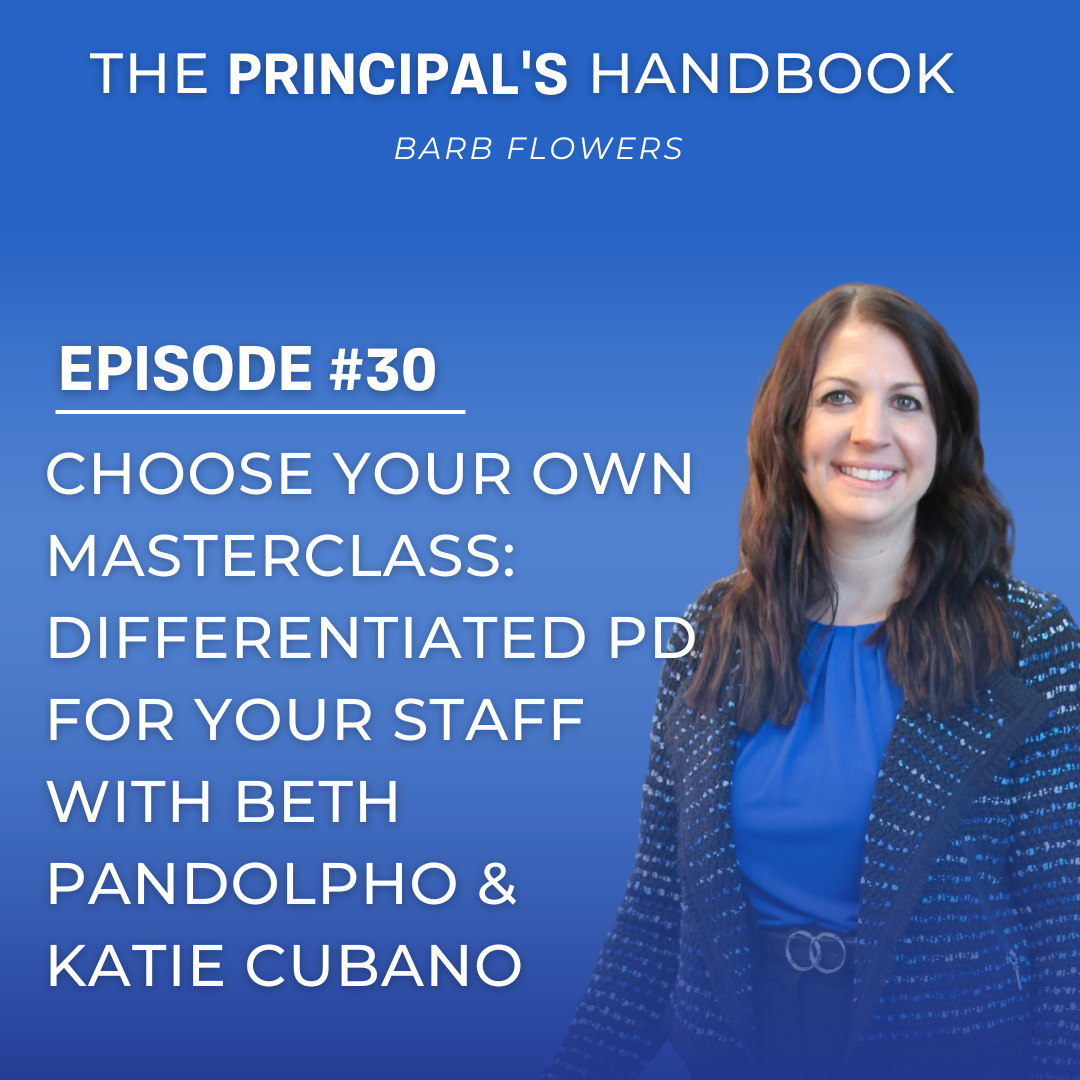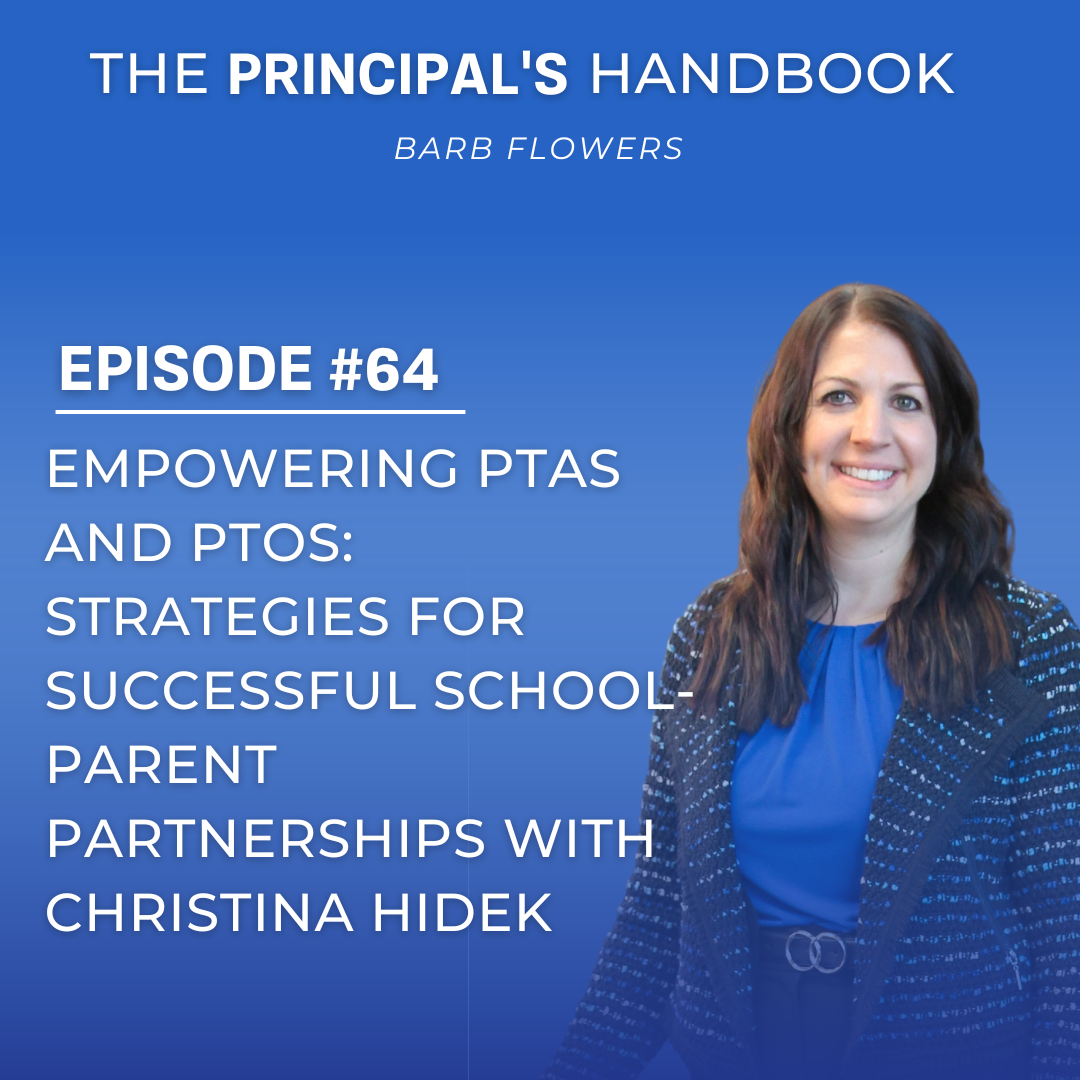[00:00:00]
In today’s episode, I have two guests with me—Beth Pandolfo and Katie Cubano, authors of the book Choose Your Own Master Class. We’ll be discussing how you can use this book to create differentiated professional development for your staff. We’ll also talk about the amount of technology students should be using in the classroom, given the time they already spend on screens each day. This promises to be an insightful conversation that you won’t want to miss. Stay tuned for all that and more, right here on The Principal’s Handbook.
[00:01:00]
Welcome to The Principal’s Handbook, your go-to resource for principals looking to revamp their leadership approach and prioritize self-care. I’m Barb Flowers, a certified life coach with eight years of experience as an elementary principal. Tune in each week as we delve into strategies for boosting mental resilience, managing time effectively, and nurturing overall wellness. From tackling daily challenges to maintaining a healthy work-life balance, I’m here to help you navigate the complexities of school leadership. Welcome to a podcast where your well-being is the top priority.
[00:02:00]
Well, welcome to the podcast! Today, I am excited to have guests with me—Beth Pandolfo and Katie Cubano, the authors of Choose Your Own Master Class. This book is truly amazing, and today we’ll talk about how it can be used in classrooms or schools. So let’s start by having the two of you introduce yourselves and tell us why you decided to write this book.
Beth Pandolfo:
I’m Beth Pandolfo. I’ve taught English for over 20 years at the high school and college level, and currently, I’m working as an instructional coach in a school district in central New Jersey, serving grades 6 through 12.
Katie Cubano:
And I’m Katie Cubano. I taught English for over a decade before transitioning into an instructional coaching role. Right now, I’m at home with my one-year-old, but I’m supervising student teachers for the College of New Jersey and loving this new way of staying connected to education.
[00:03:00]
Barb:
That’s awesome! So, let’s dive into the book. Choose Your Own Master Class is set up in a really interesting way, with standalone chapters covering different topics. What made you choose this format, and why did you decide to write the book?
Beth:
Katie and I met in 2019 when we started working as instructional coaches on the same team. We were both involved in book clubs, and we realized that, while we loved the idea of uniting people through books, there were always challenges. Faculty meetings often conflicted with book discussions, and not everyone enjoyed the same book. We thought, “How could we design a book that would appeal to everyone, withstand time between readings, and create true buy-in?” That’s how Choose Your Own Master Class was born.
Katie:
Exactly. And we also noticed that we were getting a lot of inspiration from outside of education—books by Adam Grant, Brene Brown, and podcasts like On Being. We thought, “What if we could bring these outside ideas into education and help teachers see them through an educational lens?” That’s what we’ve tried to do with the book.
Beth:
And once we stepped into the instructional coaching role, we started seeing the challenges with traditional professional development. We wanted to create something different—PD that teachers could choose based on their needs, with questions that encouraged reflection and conversations. It empowers teachers to find solutions that work for them and their students, all while lightening the lift for administrators.
Katie:
We realized that cross-disciplinary conversations bring out the most creative solutions. By using insights from thought leaders in various fields, we could help teachers think differently, and they could apply those ideas in their own classrooms. We wanted this to be an empowering, differentiated PD experience.
[00:04:00]
Barb:
I love that! Personal development is something I’m passionate about too, and I agree that there’s so much value in bringing in perspectives from outside of education. For example, I loved reading Adam Grant’s Think Again, which inspired me to approach coaching in a way that lets the person make their own decision rather than imposing it on them. It’s so much more effective when people come to their own realizations.
Katie:
That’s exactly the idea. And in the book, we’ve structured each chapter to give teachers the freedom to choose their own “masterclass.” There are reflective exercises, classroom strategies, and discussion questions that allow for personalized learning.
[00:05:00]
Barb:
That’s a great point. So, let’s talk about the topics you’ve included in the book. Could you walk us through them?
Katie:
Sure! There are six chapters, each based on a different theme. For example, Chapter 1 focuses on emotional intelligence, featuring thought leaders like Leonard Mlodinow, Mark Brackett, and Sean Ginwright. It explores how emotions impact decision-making and how educators can use this knowledge to improve classroom dynamics.
Beth:
Chapter 2 is about balancing technology use in the classroom. We look at insights from Jenny O’Dell, Cal Newport, and Johan Hari, who discuss the addictive nature of technology and offer strategies for reconnecting with students and fostering authentic conversations.
Katie:
Chapter 3 addresses fostering civil classrooms for a more civil society, with ideas from Ezra Klein, Adrienne Marie Brown, and Frances Kissling. It focuses on promoting civil discourse in the classroom and creating a space for productive, respectful conversations, even when disagreements arise.
Beth:
In Chapter 4, we talk about supporting student growth through teacher leadership. We highlight Renee Brown, Melinda Gates, and James Clear, all of whom offer valuable leadership insights that apply to both administrators and classroom teachers.
Katie:
Chapter 5 dives into reducing decision fatigue to increase equity. It includes ideas from Daniel Kahneman, Emily Oster, and Barry Schwartz, focusing on how educators can make better decisions without feeling overwhelmed by the constant demands on their time.
Beth:
And finally, Chapter 6 looks at telling stories that lead to liberation, using insights from Adam Grant, Elizabeth Gilbert, and others to explore how we talk about ourselves, our students, and our teaching practices.
[00:06:00]
Barb:
This is amazing! I especially love the focus on technology in the classroom. I know a lot of principals struggle with how much tech to use in the classroom, balancing it with the need for face-to-face interactions and connection. Can you share a bit more about the ideas in that chapter?
Katie:
Of course. This chapter emerged from our concerns as both parents and educators about the increasing screen time for students. While technology has certainly brought many benefits, the question is: How much is too much? We don’t want students glued to screens all day long, both in school and at home. The chapter offers practical strategies for rebalancing technology use, considering the cultural, individual, and societal impact.
Beth:
Exactly. We found that increased technology use doesn’t necessarily lead to better learning outcomes. Research shows that students perform better when they report low to moderate screen time in school. We want to encourage educators to think about how much technology is necessary and how to use it thoughtfully.
[00:07:00]
Barb:
This is such an important topic! As a principal, I always found it hard to strike the right balance with technology. It’s such a powerful tool, but we don’t want it to replace the invaluable human connection that happens in the classroom.
Katie:
That’s right. And that’s why we emphasize being intentional about technology use. It’s not about eliminating tech but using it thoughtfully and when it truly benefits students. We hope this chapter helps educators find that balance.
[00:08:00]
Barb:
I love that. It’s all about being mindful of how we use technology to ensure it enhances, rather than detracts from, the learning experience. So, if people want to get in touch with you or learn more about the book, how can they reach you?
Katie:
You can email me at katiebanno@gmail.com or find me on Twitter at @KatieBanno.
Beth:
And you can reach me through my website at connect@BethPandolfo.com.
[00:09:00]
Barb:
Thank you both so much for joining me today and sharing your insights. I can’t recommend Choose Your Own Master Class enough. It’s a fantastic resource for educators looking to explore fresh ideas and enhance their professional development.






